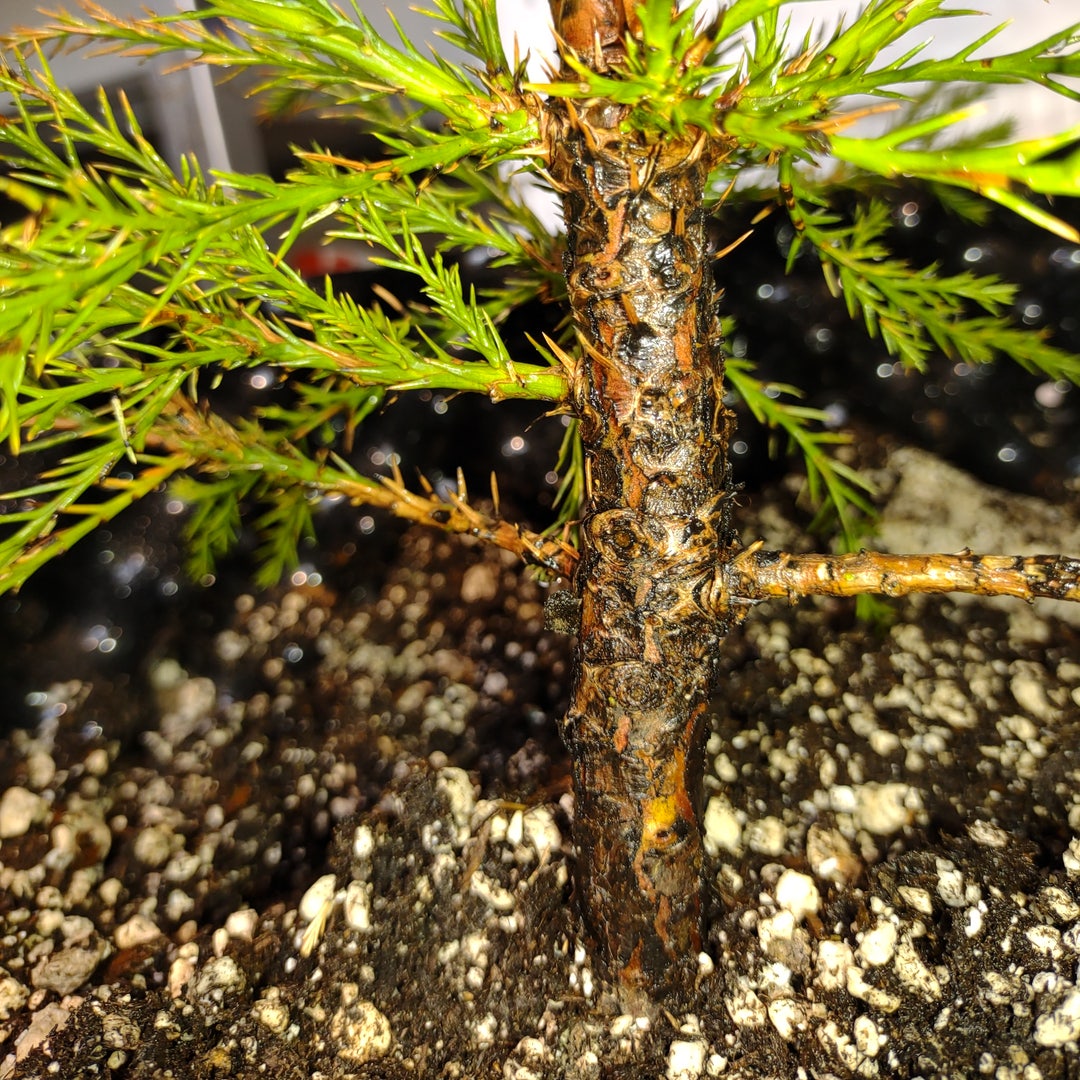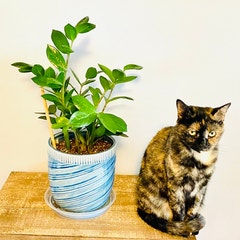Ollie finally has a confirmed diagnosis! Confirmed diagno...
 Best Answer
Best Answer
@YesMandarin Diseases
Twig & Tip Blights: Junipers frequently exhibit dieback of shoot tips or entire shoots and browning of needles. Needles may drop from the plant, and dark cankers may form at the junction of live and dead wood. This problem occurs typically during warm, wet weather conditions and is usually caused by one of the fungal organisms described below.
Phomopsis Tip Blight: This disease is caused by the fungus Phomopsis juniperovora and begins by infecting the tips of branches smaller than the diameter of a pencil.
The new, immature growth becomes infected while the darker green, mature foliage remains resistant to infection. Infected twigs first become pale, then turn reddish-brown and finally become brown after death. Scraping away the bark will reveal a sharp line between discolored, dead wood and healthy wood. Watch for disease development during the spring or summer flush of new growth when warm, wet conditions are present.
Prevention & Treatment: these diseases requires methods of control. First, closely inspect the entire plant, since symptoms of tip blight and twig blight can be caused by other problems, such as drought, overwatering, or root injury.
Purchase disease-resistant varieties that are healthy with no evidence of dead or dying twigs. Do not stress junipers by planting them in shaded or poorly drained locations. Plant junipers in areas with good air circulation to promote rapid drying of the needles. Do not crowd plants, and avoid using sprinkler irrigation. Promptly prune and remove any diseased or browning branches as they occur. Except on highly susceptible cultivars, pruning will usually control these diseases. When removing any dead branches using sterilized pruners, you can sterilize them by using rubbing alcohol.
If chemical control is necessary, fungicides are available to provide protection, but they must be applied before infection occurs. Select a fungicide labeled for use on junipers containing one of the following: mancozeb, thiophanate-methyl, or copper fungicides.
Twig & Tip Blights: Junipers frequently exhibit dieback of shoot tips or entire shoots and browning of needles. Needles may drop from the plant, and dark cankers may form at the junction of live and dead wood. This problem occurs typically during warm, wet weather conditions and is usually caused by one of the fungal organisms described below.
Phomopsis Tip Blight: This disease is caused by the fungus Phomopsis juniperovora and begins by infecting the tips of branches smaller than the diameter of a pencil.
The new, immature growth becomes infected while the darker green, mature foliage remains resistant to infection. Infected twigs first become pale, then turn reddish-brown and finally become brown after death. Scraping away the bark will reveal a sharp line between discolored, dead wood and healthy wood. Watch for disease development during the spring or summer flush of new growth when warm, wet conditions are present.
Prevention & Treatment: these diseases requires methods of control. First, closely inspect the entire plant, since symptoms of tip blight and twig blight can be caused by other problems, such as drought, overwatering, or root injury.
Purchase disease-resistant varieties that are healthy with no evidence of dead or dying twigs. Do not stress junipers by planting them in shaded or poorly drained locations. Plant junipers in areas with good air circulation to promote rapid drying of the needles. Do not crowd plants, and avoid using sprinkler irrigation. Promptly prune and remove any diseased or browning branches as they occur. Except on highly susceptible cultivars, pruning will usually control these diseases. When removing any dead branches using sterilized pruners, you can sterilize them by using rubbing alcohol.
If chemical control is necessary, fungicides are available to provide protection, but they must be applied before infection occurs. Select a fungicide labeled for use on junipers containing one of the following: mancozeb, thiophanate-methyl, or copper fungicides.
@kikisoasis Thank you! I've been reading a lot about this too, the more I learn, the more questions I have and I feel I may be asking questions in the wrong place sometimes but I have honestly learned more from everyone else posting here in this app than from...well, let's just say several very prominent plant and tree sources. So thank you. This was a beautiful tree when I first got it and it sadly took me awhile to learn about it's fungus problem. I had no idea the problem could be dormant the year prior. If so, I could have avoided all of this. So lesson learned, I'm planning on researching all about specific plant diseases and care before buying another one. Also, the way different plants interact with each other and can make each other sick.
In regards to Ollie, I waited way too long to treat it because I didn't know what was wrong and I was worried using the wrong chemicals could do more harm. I've skipped the other fungicides listed and went straight to the systemic control, hoping to protect the main stem and ultimately the tree as a whole, even if it means losing all the branches. I'll probably start slowly mixing in the other ones listed too. Fingers crossed. In my research, all the chemicals recommended are for Phomopsis juniperovora, which is what Ollie has, although what's interesting is that Ollie is a giant sequoia tree and Phomopsis juniperovora is usually but not always found on junipers. So, I've had a hard time finding good sources specifically discussing those chemicals on sequoia trees and it's effectiveness for that fungus. It's been a fun project though, I've actually went back to articles from 1864, well before any treatment existed or they even had a name for it.
In regards to Ollie, I waited way too long to treat it because I didn't know what was wrong and I was worried using the wrong chemicals could do more harm. I've skipped the other fungicides listed and went straight to the systemic control, hoping to protect the main stem and ultimately the tree as a whole, even if it means losing all the branches. I'll probably start slowly mixing in the other ones listed too. Fingers crossed. In my research, all the chemicals recommended are for Phomopsis juniperovora, which is what Ollie has, although what's interesting is that Ollie is a giant sequoia tree and Phomopsis juniperovora is usually but not always found on junipers. So, I've had a hard time finding good sources specifically discussing those chemicals on sequoia trees and it's effectiveness for that fungus. It's been a fun project though, I've actually went back to articles from 1864, well before any treatment existed or they even had a name for it.









 2
2


